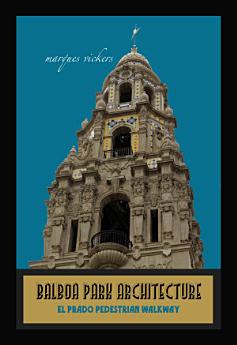Balboa Park Architecture: El Prado Pedestrian Walkway
About this ebook
The majority of buildings introduced during the first exposition outside of the California Quadrangle were temporary by intent, constructed in wood and plaster. Most of these remained standing for nearly eighty years even during a subsequent fair in 1935-36. Eventually each of these structures would be demolished and reconstructed with sturdier materials. The fresher building designs remained identical to the previous temporary structures.
Integrated throughout the initial Exposition design were a variety of European architectural styles. For southern California spectators, this diverse assortment would result in popularizing Spanish-Renaissance styling throughout the region. Decades of similarly themed constructions followed and dominated the region’s architecture. It is not an extended stretch to suggest the genesis of contemporary California style had its birth from the Exposition.
Balboa Park Architecture is an extensive photographic survey of the structures introduced during the 1915-16 Exposition. The edition escorts the reader through an intimate tour of the El Prado pedestrian walkway from the current Laurel Street Bridge to the Bea Evenson Fountain. Detailed images of exterior building finishes and the structures offer an insightful glimpse of lead architect Bertram Goodhue’s vision.
Goodhue is credited with introducing a wider American audience to the traditional Spanish Baroque and Spanish Colonial styles of architecture. Blending these influences with Italian Churrigueresque style, he fashioned a hybrid that would become known as the Spanish Colonial Revival form. This fusion became a dominant theme within the El Prado Quadrangle’s layout during the 1915-16 Panama-California Exposition in Balboa Park.
The exposure and success of Exposition became a highly influential factor in the development of a distinct Southern California style of architecture. The Spanish Colonial Revival style became the predominant design in the rebuilding of Santa Barbara following a devastating 1925 earthquake. The style remains prevalent throughout California and the Southwestern United States.
Following the Exposition, Goodhue’s creations became increasingly freed of architectural detail and considered more Romanesque in form. He worked towards a more synthesized and simplistic design many credit as paving the next phase of architectural idioms. Where this direction may have evolved was abruptly terminated upon his premature death.
Goodhue died abruptly at the age of 54 in New York City. He was buried within a wall vault at his Church of the Intercession in Manhattan on the border of the Harlem and Washington Heights neighborhoods. Sculptor Lee Lawrie created a Gothic stylized tomb for him.
About the author
Author, photographer and visual artist Marques Vickers was born in 1957 in Vallejo, California. He graduated from Azusa Pacific University in Los Angeles and became the Public Relations and Executive Director for the Burbank, California Chamber of Commerce between 1979-84.
Professionally, he has operated travel, apparel, wine, rare book and publishing businesses. His paintings and sculptures have been exhibited in art galleries, private collections and museums in the United States and Europe. He has previously lived in the Burgundy and Languedoc regions of France and currently lives in the South Puget Sound region of Western Washington.
He has written and published over one hundred books spanning a diverse variety of subjects including true crime, international travel, social satire, wine production, architecture, history, fiction, auctions, fine art, poetry and photojournalism.
He has two daughters, Charline and Caroline who reside in Europe.











